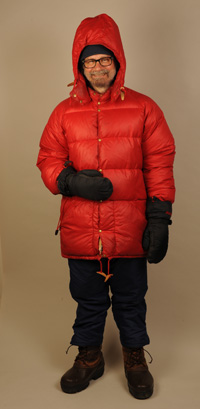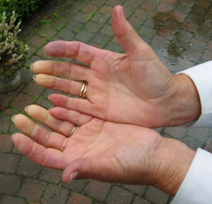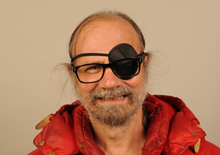It's easy to stay warm on cold winter nights if you dress appropriately — and take a few common-sense precautions.
Astronomy tends to be a chilly hobby. Everywhere outside the tropics gets cold at night in some seasons, and many places can get cold at any time of year. There are three possible strategies for dealing with this fact: stay inside when it’s cold, pretend it’s not cold and suffer accordingly, or dress appropriately. You can probably guess which strategy I prefer!

Here's what the author wears in moderate cold, around 20°F. Every inch of his body except his face is insulated with amply thick clothing.
S&T: Dennis diCicco
I discuss cold-weather clothing at length in the December 2013 issue of Sky & Telescope. For the moment, I will just state the salient principles:
If you're winterizing a room with four windows, there's not much point in double-glazing three and leaving the fourth wide open. Heat always escapes through whatever path is insulated least. Likewise, in winter, you need to wear extra clothing everywhere, not just on your arms and torso. No jacket will keep you warm if your head is bare, or if you're wearing nothing but blue jeans on your legs. A chain is only as strong as its weakest link.
Assuming that your clothing has a windproof shell, its insulating value depends almost entirely on its thickness; it doesn't really matter what it's made of. Two inches of wool — or newspaper — is equal in warmth to two inches of down or polyester fiber. But wool and newspaper are a lot heavier and stiffer than down or polyester fiber.
There are a lot of other things you can do to stay warm besides wearing adequate clothing. Your body burns lot of calories in cold weather, and a high-carb snack can work wonders to warm you up. Hot drinks are particularly useful. I've never been sure whether it's physiological or psychological — and perhaps it doesn't matter. But when I drink a cup of hot cocoa in cold weather, I feel a surge of warmth spreading through me from the inside out.
Wearing plenty of clothing all over your body is necessary, but not sufficient, to keep your hands and feet warm. Internal organs are essential while hands and feet are dispensable, so your body cuts off ciculation to the extremities as soon as its core gets cold. But even if your core is warm, it's hard to pump enough blood to your hands and feet to keep them warm, especially when you're not moving.

A person with Reynaud's phenomenon can lose circulation to his or (more likely) her hands and feet in even modestly cool conditions, when the rest of her body is quite warm.
Jamclaassen / Wikimedia Commons
One condition to be aware of is Raynaud's phenomenon, where blood to the extremities is cut off prematurely, causing them to turn yellow and then blue. People with this condition are especially prone to frostbitte. It's much more common among women than men; my wife has a mild case. The only recourse is to supply external heat.
Keep your thick mittens on whenever possible, avoid using your hands except when needed, and keep them low to maximize blood supply. I also swear by chemical hand warmers. If your hands get cold anyway, warm them up in pants pockets, armpits, or on your neck.
Putting weight on your feet cuts off the blood flow; sitting is much better than standing. Use a mat or newspaper to insulate them from snow. Wiggle your toes. And taking periodic breaks for 5-minute jogs works wonders all around, warming you up and getting your blood flowing. If your feet get cold nonetheless, take off your boots and massage your feet to restore the blood flow. (Better done indoors, but effective even in the cold.)

An eyepatch helps preserve your dark adaptation if you go into a lighted room to warm up.
S&T: Dennis diCicco
If you have a warm place to retreat to warm up, by all means do so! This is the perfect place for that warm snack, or to massage your feet, or to plan the next phase of your observing session. If there are other people indoors and you can't turn off the lights, wear an eye patch to preserve dark adaptation.
At remote locations, some people warm up inside idling cars, but I consider this an extreme emergency measure. It's bad for your engine, bad for the environment, and illegal in the state I live in (Massachusetts). Contrary to widespread superstition, driving the car is actually better for the engine, produces less pollution, and certainly gets it warm much faster. However, the headlights will inevitably damage your dark adaptation.
 2
2
Comments
Anthony Barreiro
October 11, 2013 at 1:38 pm
Thanks Tony for this very helpful information and advice. Even here in coastal northern California, where it rarely gets below freezing, people need to learn how to dress warmly to enjoy spending hours with a telescope at night. Even if the air temperature is not too cold, under a clear sky at night the ground and your body are losing heat to space, whereas during the day, at the exact same air temperature, the Sun is warming the ground and your body. Insulated boots have been a godsend for me, now my feet stay warm.
You must be logged in to post a comment.
Ronn Blankenship
October 11, 2013 at 8:02 pm
Some years ago I spent the spring term teaching basic astronomy at a university in Colorado while the regular prof was on sabbatical. Before the first night lab, I reminded my students several times that no matter how warm it might be during the day, it would rapidly get uncomfortably cold as soon as the Sun went down. The day of the first clear night was warm enough that many students came to class dressed in T-shirts and shorts, and, even though I reminded them again, some of them showed up that night still dressed that way, and some of them expressed to others that because I am from Alabama I obviously wasn't used to the local climate because I arrived carrying a parka with fur-trimmed hood and thick Gore-Tex gloves. By the time we were ten or fifteen minutes into a two-hour lab period, I was quite comfortable wearing what I had brought while those who were dressed inadequately were shivering. One thing about dressing too lightly for observing, though: people seldom make that same mistake twice . . .
You must be logged in to post a comment.
You must be logged in to post a comment.